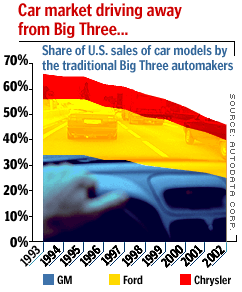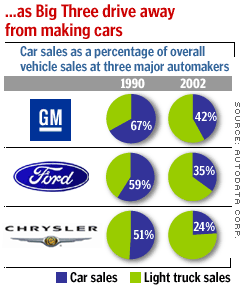NEW YORK (CNN/Money) -
The Big Three automakers are putting a new emphasis on an old, nearly forgotten product -- the passenger car.
After years of spending most of their product development dollars on new sport/utility vehicles, pickup trucks and minivans, General Motors Corp. (GM: Research, Estimates), Ford Motor Co. (F: Research, Estimates) and Chrysler are making a renewed push for new versions of traditional car models in the coming years.
But the move is a big risk: For years, the Big Three have lost money on their passenger cars, and made money on light trucks.

GM said its product development budget, which was weighted nearly two-to-one in favor of trucks for the past few years, now is tilted almost two-for-one in favor of cars. New car models will outnumber new truck models three to one among the 16 vehicles GM will launch in the United States this year, and the same split is planned for next year, GM spokesman Tom Kowaleski said
"It's a huge market that needs to be given attention," Kowaleski said. "There still is 48 or 49 percent [of vehicle buyers] buying cars."
Ford, which this year is rolling out a new version of the nation's best-selling vehicle, the F-150 pickup, as well as two new minivans, says next year will be the "year of the car," with new car introductions outnumbering trucks for the first time since 1999. And Chrysler says 14 of the 21 vehicles planned for release in the model years 2003 through 2005 will be cars rather than trucks.
Detroit's new car focus on cars is aimed at stemming gains by overseas automakers, who have made gains among buyers who want to stay in cars. The Big Three's share of the car segment of the new vehicle market has fallen from 66 percent in 1993 to just 46 percent last year, according to Autodata, a New Jersey firm that tracks industry sales.

The automakers insist that the current increase in fuel prices is not the reason for the shift in focus. Sales of less fuel-efficient light trucks have held up surprisingly well despite higher gas prices, and the plans to put more emphasis on cars started long before prices started rising at the pump.
"You don't flip a switch and go to cars. These are things that have been on drawing boards, and in planning, for a number of years," Ford spokesman Said Deep said.
But improved car sales are key to helping the Big Three comply with federal fuel economy standards that judge the average fuel economy of each automaker's entire fleet of new vehicles sold. It also is important if consumers become convinced that higher fuel prices are here to stay.
"They need to beef up that part of the lineup to avoid what could be a catastrophic problem if we see a sudden elevation in passenger car preference," said Mike Flynn, director of the office for study of automotive transportation at the University of Michigan.
Do buyers want Detroit's car designs?
But big questions loom, among them: Will Detroit automakers will be able to stem their falling car sales with their new designs?
Even Detroit's most recent new designs, such as last fall's Saturn Ion from GM, often are seen by buyers and auto reviewers as trailing competing Japanese offerings such as the Toyota Corolla and Honda Civic, and the Ion's sales have lagged even GM's own projections.
The next question: If the Big Three can build cars that U.S. consumers want again, industry analysts wonder if they'll be able to make money building them.
"The passenger cars are not inherently as profitable as big SUVs or big pickups, but they have to refurbish their car line, even if it doesn't get them back to historical profit margins," said David Healy, auto analyst at Burnham Securities. While luxury cars can be as profitable as the most profitable light trucks, he said, many entry-level cars probably still will be money losers for the Big Three.
"The question is, does it make sense to pour more money into a new Chevy Cavalier to reduce losses from $3,000 per vehicle to $1,000," Healy said. "It's probably a necessary competitive move."
The shift of product development resources and attention should help produce more competitive vehicles, the University of Michigan's Flynn said. "If it is no longer the kiss of death for your career as a designer to be working in passenger cars, they [the automakers] will do fine. They have the wherewithal to be competitive," he said.
| Related stories
|

|
|
|
|
Japanese and other overseas automakers are making money on their car lines, even on vehicles built at their North American plants. Burnham's Healy said lower pension and health-care costs, plus better productivity at those newer plants, gives the Japanese automakers an edge, and thus more incentive to invest in car models.
The Toyota Camry and Honda Accord, both of which have been redesigned recently, compete annually to be the best selling car in the U.S. The Ford Taurus, which once held that title, has not been redesigned since the 1999 model, and even with its new focus on cars, Ford won't say when it plans a new version of the vehicle.
Click here for a look at auto stocks
One thing Detroit's automakers are doing to compete with overseas automakers on car development costs is turning to overseas partners.
Chrysler is using more technology from Mercedes-Benz, the other main unit of its DaimlerChrysler (DCX: Research, Estimates) parent, in its car designs. GM will start importing its new subcompact, the Avio, from its new Korean joint venture, GM Daewoo, and its reintroduced Pontiac GTO will be built in Australia by its Holden unit.

|

